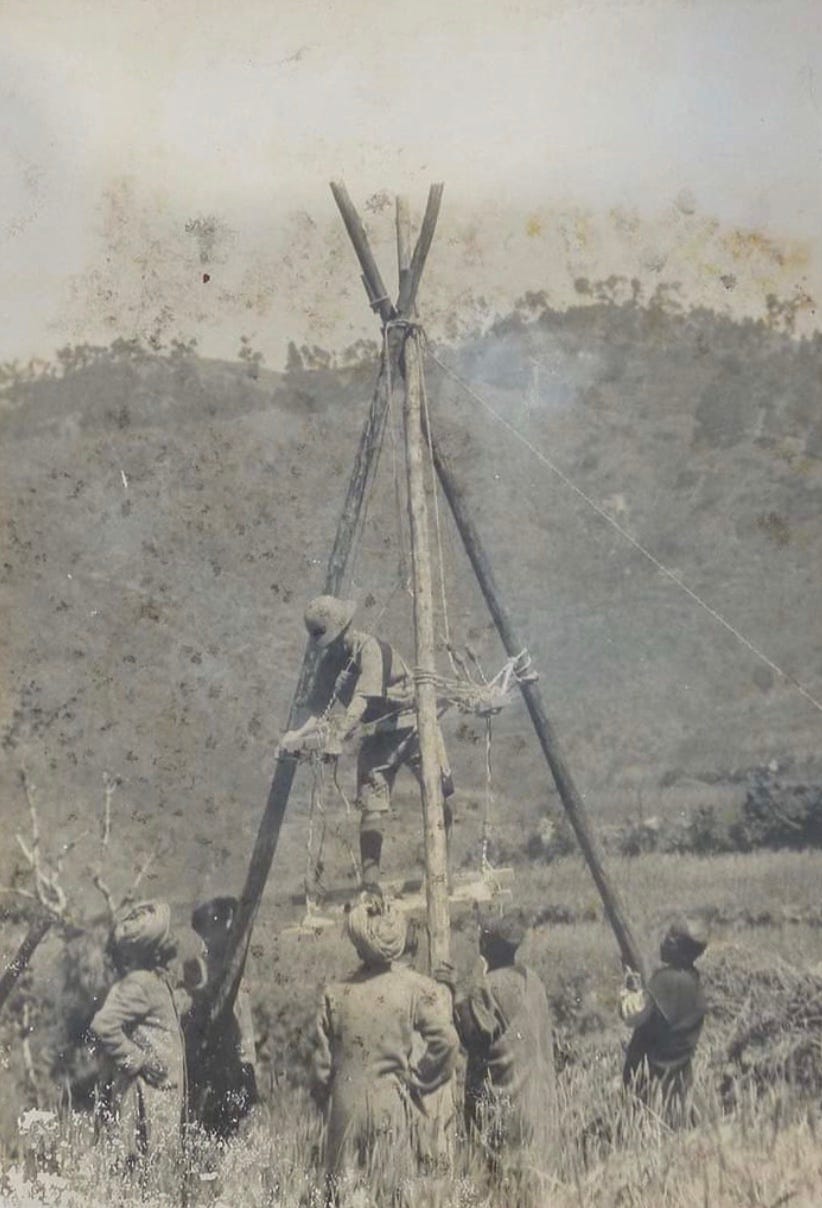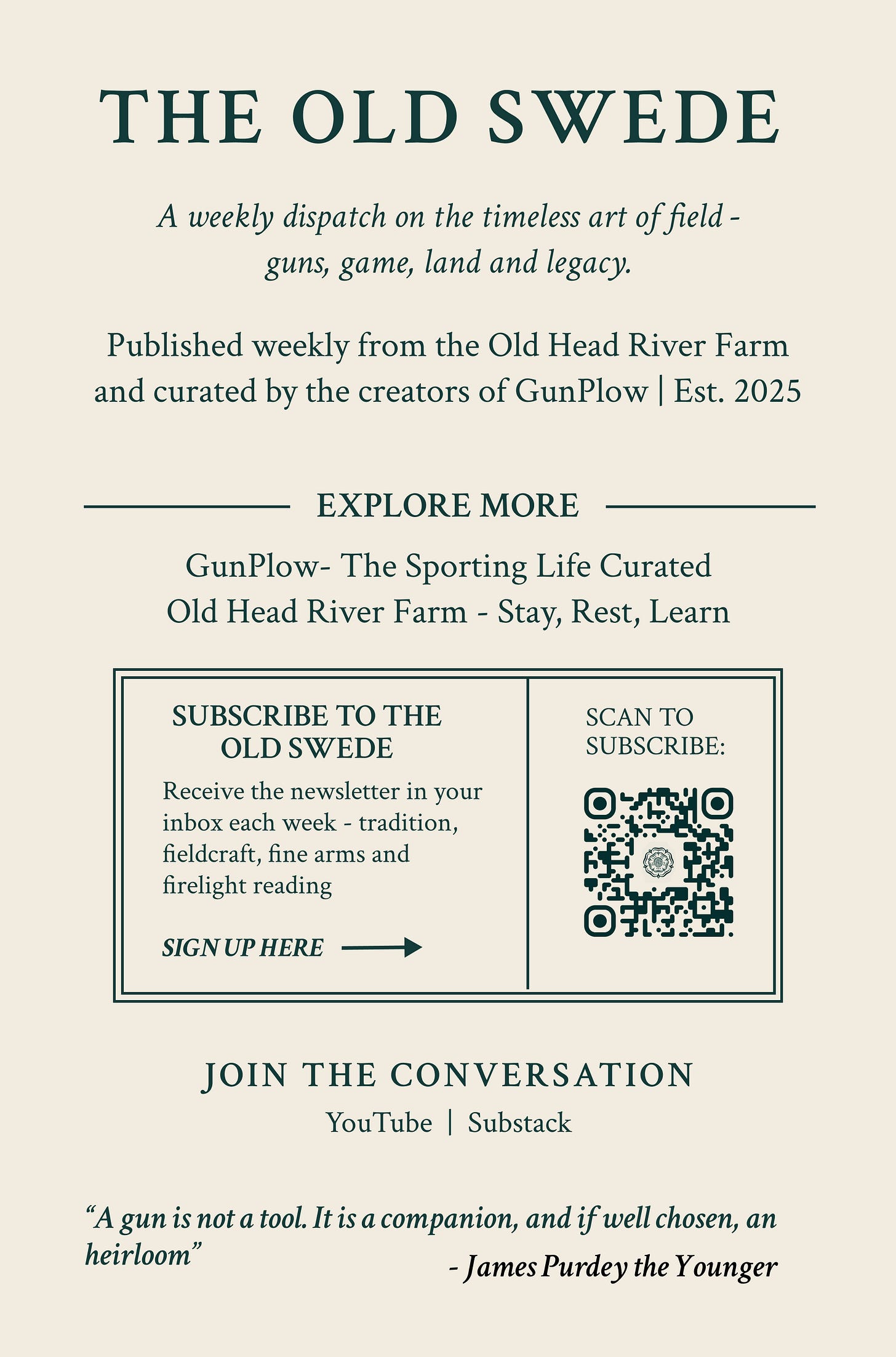The Old Swede: September 3rd, 2025
Gentleman in the Field: A Life Measured in Miles Walked, Dogs Led, and Meals Earned
A Scene or Historical Anecdote
The Fearless Demeanor of a PH on Safari
To watch a veteran Professional Hunter (PH) walk into thick bush behind a wounded bull elephant or man-eating lion is to witness composure made flesh. There is no panic, no swagger. Just steadiness the mark of thousands of hours spent tracking, watching, and, if needed, ending.
The best PHs project calm in the face of uncertainty. They walk slower as the danger rises, not faster. Their voice lowers, not raises. Their rifle is held loosely but always ready. Clients often recount that just being near such a man eases the pulse. The hunter is allowed to focus, knowing that behind him is a guardian with nerves like braided steel.
This composure isn’t bravado. It’s earned from days under the African sun, nights listening to lions breathe outside the tent, and years of understanding how quickly a hunt can turn.
The PH never boasts. He does not seek the shot. He simply ensures that when it must be taken, it is taken cleanly and that everyone walks home.
Reference:
Horn of the Hunter by Robert Ruark; Safari: A Chronicle of Adventure by Bartle Bull
Manners Maketh Man
Etiquette in Safari Camp
In the African bush, where adrenaline and isolation meet, etiquette becomes more important, not less. The best safari camps maintain a tone of calm civility, where even the most dangerous game is balanced by the rituals of tablecloths, candlelight, and quiet conversation.
Dinner is the anchor. It is not a rushed affair, but a ceremony: linen napkins, polished silver, and three course meals prepared over charcoal. You do not arrive in tank tops or muddy boots. You change, even if only into clean khakis. And you arrive on time.
Silence is valued. Around the fire, let the PH speak if he chooses. Stories are earned in these parts, not offered like bar banter. Don’t question every decision afield. Respect is shown in stillness, and trust is built by listening.
Clients who thrive in safari camp are those who blend in. They praise the tracker. They pour a glass for the skinner. They know that everyone, from the gun bearer to the camp cook, is vital to the success of the experience.
A quiet hunter, who eats well, shoots straight, and tips properly, is remembered. And remembered fondly.
Reference:
Death in the Long Grass by Peter Hathaway Capstick
Kit Review
The Right Gun for Dangerous Game
When it comes to dangerous game, buffalo, lion, elephant, the right rifle isn’t a luxury; it’s a necessity. Tradition still favors the double rifle in .470 Nitro Express or .500 NE. These side-by-sides, often from makers like Westley Richards, Rigby, or Heym, offer speed, reliability, and balance.
A bolt-action .375 H&H remains the standard by which all others are measured—enough gun for lion, and legal minimum for elephant in most countries. Its flat trajectory, manageable recoil, and deep penetration make it the gentleman’s working rifle.
Beyond caliber, the rifle must fit. A short length of pull can cost seconds—and your life. Open sights are mandatory, but a low-mount scope adds confidence. Sling studs are best left off.
You don’t need the fanciest gun in camp. But you do need one that works—every time, in every condition, and that you’ve trained with until it’s second nature.
Recommended:
Rigby Big Game .416
Heym 89B .500 NE
Westley Richards .470 NE
Spirit of the Week
Gin and Tonic: The Malaria Killer
The gin and tonic is more than a colonial relic. It’s a survival story in a glass. Originally prescribed by British officers in India and Africa, tonic water’s quinine content was used to ward off malaria. But its bitter taste led to a brilliant idea: add gin.
What emerged became the signature sundowner of every safari. It cools the nerves, revives the senses, and stirs the appetite all without demanding attention. The ritual is simple: one part gin, three parts tonic, over ice, with a wedge of lime. In the field, it’s served at golden hour, just after rifles are cleaned and stories begin to uncoil.
Hendrick’s offers cucumber freshness. Sipsmith delivers London dry clarity. But on safari, many still prefer Gordon’s clean, sharp, classic. Fever-Tree or Schweppes are acceptable tonics; avoid low-quinine impostors.
Raise your glass not just to good health, but to tradition, the drink that turned medicine into pleasure.
Reference:
Gin: The Manual by Dave Broom; African Game Trails by Theodore Roosevelt
Bar Spotlight
The Nairobi Bar from Capstick’s Africa
In Death in the Long Grass, Peter Capstick describes the Nairobi bar scene as a blend of danger, legend, and cigar smoke thick enough to write your will on. One bar in particular, never fully named, became a refuge for PHs, writers, and rogues alike. It wasn’t on a tourist map, but everyone who mattered knew how to find it.
Capstick wrote of late nights with characters who had tracked lions barefoot, survived buffalo gorings, or guided European royalty. The bar was loud, the drinks stiff, and the laughter dark. PHs toasted to the ones who didn’t come back. Bottles of gin were consumed like water. The bartenders knew who had a fresh scar and who had a fresh story.
It was here that safari plans were hatched, rifles traded, and legends cemented. It wasn’t about décor. It was about presence. You didn’t brag in that bar. You earned your place at the table by what you’d done in the bush.
Today, the bar is likely gone or renamed. But its spirit lives on in every firelit camp where stories are told long after the guns are stowed.
Reference:
Death in the Long Grass by Peter H. Capstick
Safari Tale
Jim Corbett and the Man-Eaters
Few names command more respect in the realm of dangerous game than Jim Corbett—the British-Indian hunter, conservationist, and writer who tracked and killed dozens of man-eating tigers and leopards that plagued remote villages.
Corbett’s hunting was never sport. It was service. He ventured alone into the Himalayan foothills, often under cover of darkness, armed with his trusted .275 Rigby bolt-action rifle. The Champawat Tiger, his most famous quarry was responsible for over 400 human deaths before Corbett ended its reign in 1907.
His demeanor was gentle, almost monastic. He respected the animals he hunted, understanding that injury or desperation had driven them to prey on humans. He was as much naturalist as marksman.
In later years, Corbett became a staunch conservationist, playing a key role in establishing India’s first national parks. His legacy lives not only in the villages he saved, but in the books he left behind.
“A hunter with a conscience and a cause.”
Recommended Reading:
Man-Eaters of Kumaon by Jim Corbett; Jungle Lore by Jim Corbett






